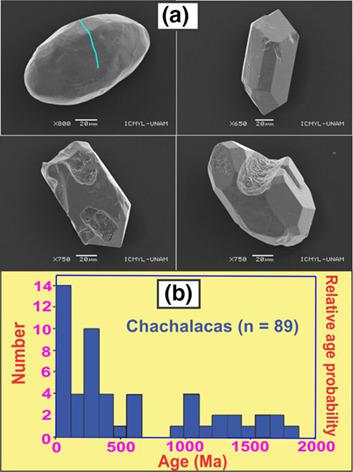当前位置:
X-MOL 学术
›
Geolog. J.
›
论文详情
Our official English website, www.x-mol.net, welcomes your
feedback! (Note: you will need to create a separate account there.)
Microtexture and U–Pb geochronology of detrital zircon grains in the Chachalacas beach, Veracruz State, Gulf of Mexico
Geological Journal ( IF 1.4 ) Pub Date : 2020-09-14 , DOI: 10.1002/gj.3984 John S. Armstrong‐Altrin 1 , Mayla A. Ramos‐Vázquez 2 , Nadia Y. Hermenegildo‐Ruiz 3 , Jayagopal Madhavaraju 4
Geological Journal ( IF 1.4 ) Pub Date : 2020-09-14 , DOI: 10.1002/gj.3984 John S. Armstrong‐Altrin 1 , Mayla A. Ramos‐Vázquez 2 , Nadia Y. Hermenegildo‐Ruiz 3 , Jayagopal Madhavaraju 4
Affiliation

|
Microtextures, trace element concentrations, and U–Pb geochronology of detrital zircon grains recovered from the Chachalacas beach in the western Gulf of Mexico were investigated to infer palaeoenvironmental conditions. The mineralogy of bulk sediments revealed the presence of both chemically stable (titano‐magnetite, zircon, and quartz) and unstable (amphibole and K‐feldspar) minerals. The zircon grain microtextures or surface features were grouped as two types: (a) mechanical origin and (b) mechanical and chemical origin. The mechanical surface features such as V‐marks, arc shaped, and meandering steps indicate a high‐energy littoral and sub‐aqueous marine environment. The chemical surface features like solution pits, precipitation, solution crevasses, adhered particles, and silica pellicle revealed a silica saturated marine environment. The well‐rounded zircon grains with bulbous edges are characterized by long transport and aeolian origin. The Th/U ratio, a negative Eu (Eu/Eu* = ~0.08–0.72) and positive Ce (Ce/Ce* = >1) anomalies in the chondrite‐normalized REE patterns of all zircon grains suggested that they primarily formed from magmatic processes. The detrital zircon grain U–Pb ages showed a wide variation from Cenozoic to Proterozoic with an abundance of Cenozoic ages (~1.59–64.3 Ma; n = 44), interpreted as mixing of beach sediments by a longshore current. The comparison of zircon grain ages of this study with ages reported from the source terranes revealed that the likely source for Cenozoic zircon grains was the Eastern Alkaline Province of Mexico. Similarly, the Mesozoic (~68.5–241.9 Ma) and Palaeozoic (~253.2–284.8 Ma) zircon grains in the Chachalacas beach were possibly derived from the Valle de Huizachal and Mesa Central provinces. Proterozoic ages from ~574 to 1846 Ma indicated a probable contribution from the Oaxacan and Chiapas Massif complexes, which are dominated by Grenvillian basement rocks.
中文翻译:

墨西哥湾韦拉克鲁斯州Chachalacas海滩中碎屑锆石晶粒的微观组织和U–Pb年代学
从墨西哥西部海湾Chachalacas海滩回收的碎屑锆石的微观结构,痕量元素浓度和U–Pb年代学进行了研究,以推断古环境条件。大块沉积物的矿物学特征表明存在化学上稳定的(钛磁铁矿,锆石和石英)和不稳定的矿物(闪石和钾长石)。锆石晶粒的微观结构或表面特征分为两种类型:(a)机械起源和(b)机械和化学起源。机械表面特征(如V形标记,弧形和曲折台阶)表示沿海和水下水下环境的能量较高。化学表面特征如溶液坑,沉淀,溶液裂缝,粘附的颗粒和硅石薄膜都显示出硅石饱和的海洋环境。具有球形边缘的圆润锆石颗粒具有长运输和风成因的特征。在所有锆石晶粒的球粒陨石归一化REE模式中,Th / U比,负Eu(Eu / Eu * =〜0.08-0.72)和正Ce(Ce / Ce * => 1)异常表明它们主要是由岩浆过程。碎屑锆石的U–Pb年龄在新生代到元古代之间有很大的差异,新生代年龄丰富(〜1.59–64.3 Ma;n = 44),解释为沿岸洋流将海滩沉积物混合。这项研究的锆石年龄与源地层报告的年龄进行比较后发现,新生代锆石颗粒的可能来源是墨西哥东部碱性省。同样,Chachalacas海滩的中生代(〜68.5–241.9 Ma)和古生代(〜253.2–284.8 Ma)锆石颗粒可能来自瓦莱德·韦扎查尔河谷和梅萨中部省。大约574到1846 Ma的元古代年龄表明,瓦哈卡人和恰帕斯州地块复合体的贡献可能很大,这些复合体以格伦维利基底岩为主导。
更新日期:2020-09-14
中文翻译:

墨西哥湾韦拉克鲁斯州Chachalacas海滩中碎屑锆石晶粒的微观组织和U–Pb年代学
从墨西哥西部海湾Chachalacas海滩回收的碎屑锆石的微观结构,痕量元素浓度和U–Pb年代学进行了研究,以推断古环境条件。大块沉积物的矿物学特征表明存在化学上稳定的(钛磁铁矿,锆石和石英)和不稳定的矿物(闪石和钾长石)。锆石晶粒的微观结构或表面特征分为两种类型:(a)机械起源和(b)机械和化学起源。机械表面特征(如V形标记,弧形和曲折台阶)表示沿海和水下水下环境的能量较高。化学表面特征如溶液坑,沉淀,溶液裂缝,粘附的颗粒和硅石薄膜都显示出硅石饱和的海洋环境。具有球形边缘的圆润锆石颗粒具有长运输和风成因的特征。在所有锆石晶粒的球粒陨石归一化REE模式中,Th / U比,负Eu(Eu / Eu * =〜0.08-0.72)和正Ce(Ce / Ce * => 1)异常表明它们主要是由岩浆过程。碎屑锆石的U–Pb年龄在新生代到元古代之间有很大的差异,新生代年龄丰富(〜1.59–64.3 Ma;n = 44),解释为沿岸洋流将海滩沉积物混合。这项研究的锆石年龄与源地层报告的年龄进行比较后发现,新生代锆石颗粒的可能来源是墨西哥东部碱性省。同样,Chachalacas海滩的中生代(〜68.5–241.9 Ma)和古生代(〜253.2–284.8 Ma)锆石颗粒可能来自瓦莱德·韦扎查尔河谷和梅萨中部省。大约574到1846 Ma的元古代年龄表明,瓦哈卡人和恰帕斯州地块复合体的贡献可能很大,这些复合体以格伦维利基底岩为主导。











































 京公网安备 11010802027423号
京公网安备 11010802027423号